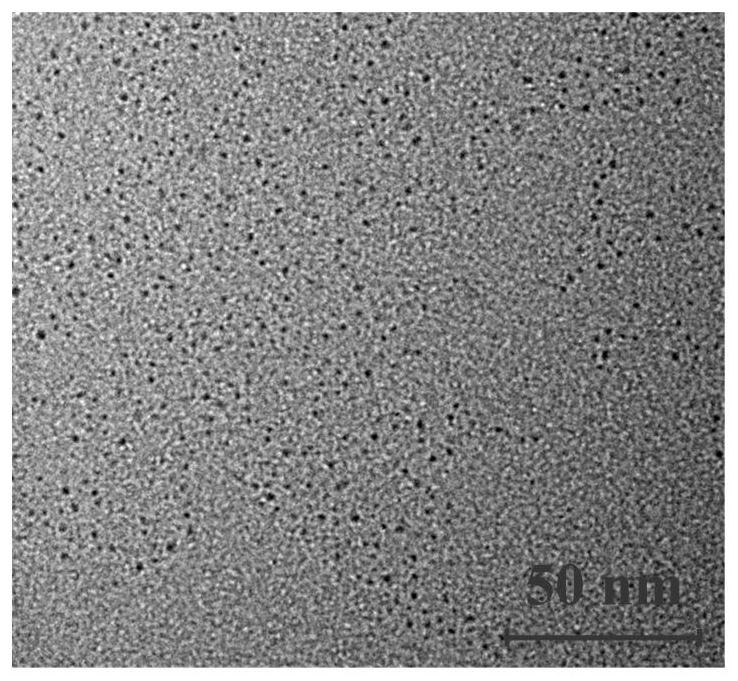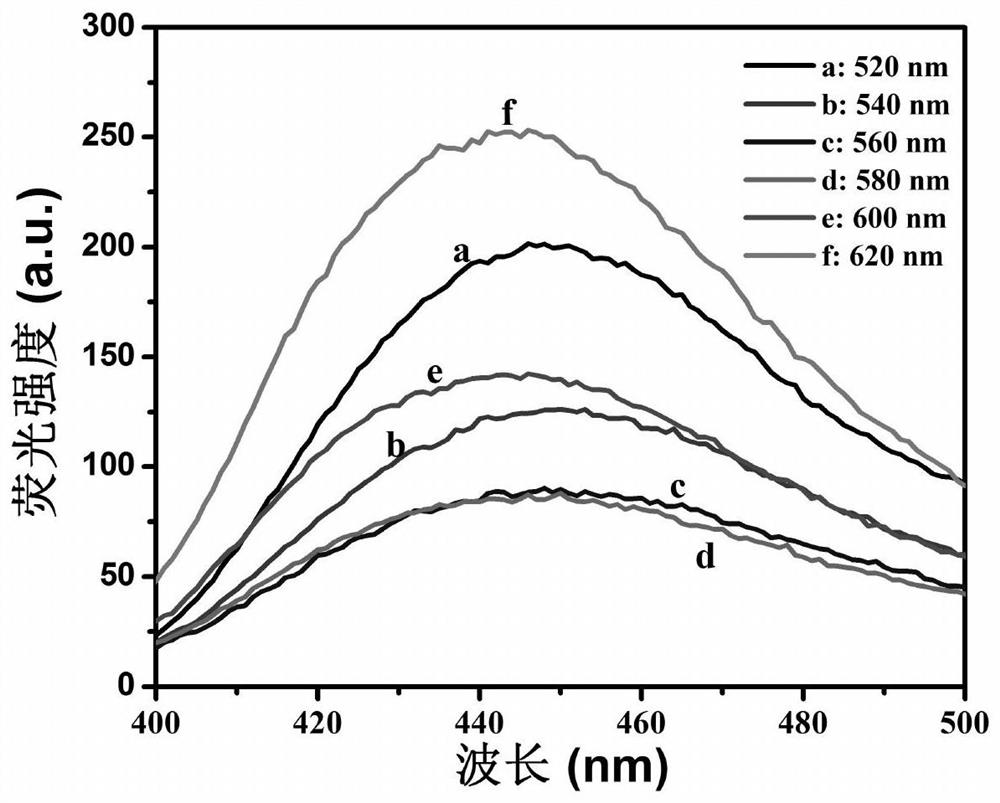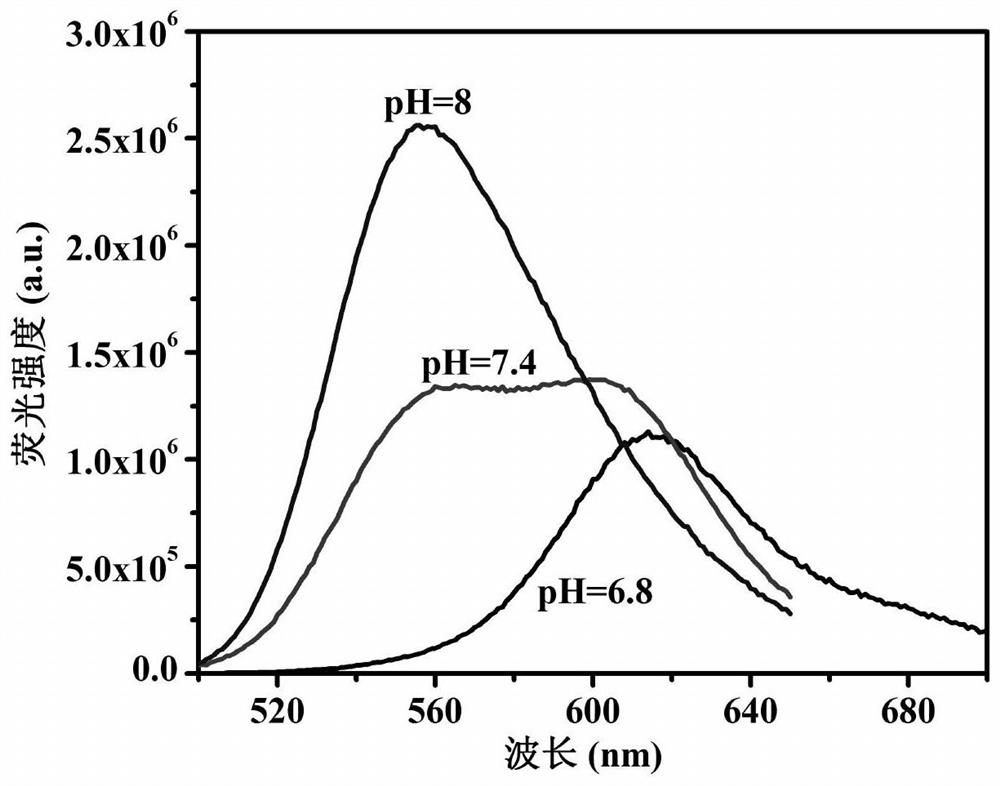A bioluminescence-triggered upconversion carbon quantum dot-protoporphyrin ix composite photosensitizer and its preparation method
A technology of carbon quantum dots and photosensitizers, applied in the field of up-conversion carbon quantum dots-protoporphyrin IX composite photosensitizers, can solve problems such as unexperimental verification of biological hazards of high-energy rays
- Summary
- Abstract
- Description
- Claims
- Application Information
AI Technical Summary
Problems solved by technology
Method used
Image
Examples
Embodiment 1
[0027] A method for preparing a bioluminescence-triggered upconversion carbon quantum dot-protoporphyrin IX composite photosensitizer, comprising the following steps:
[0028] 1) Dissolve 2.1g of anhydrous citric acid in 50ml of deionized water, then add 2.7ml of ethylenediamine, and stir thoroughly to form a colorless, transparent and uniform solution;
[0029] 2) Put the above solution in a tetrafluoroethylene-lined stainless steel reaction kettle, react at 200°C for 5h, cool the reaction product to room temperature, dialyze for 48h, obtain carbon quantum dots (CDs) after freeze-drying, and then take 0.5mg of CDs to dissolve In 5ml Tris solution (pH=8.0);
[0030] 3) 1 mg of protoporphyrin IX (PIX) was dissolved in 1 ml of dimethyl sulfoxide, and 1 mg of 1-(3-dimethylaminopropyl)-3-ethylcarbodiimide hydrochloride (EDC) and 0.6 mg of N - Hydroxysuccinimide (NHS), activate the carboxyl group of PIX for 30min.
[0031] 4) Add 5ml of Tris solution (pH=8.0) with CDs dissolved in ...
Embodiment 2
[0039] A method for preparing a bioluminescence-triggered upconversion carbon quantum dot-protoporphyrin IX composite photosensitizer, comprising the following steps:
[0040] 1) Dissolve 1.4g of anhydrous citric acid in 50ml of deionized water, then add 1.8ml of ethylenediamine and stir thoroughly to form a colorless, transparent and uniform solution.
[0041] 2) Put the above solution in a tetrafluoroethylene-lined stainless steel reaction kettle, react at 200°C for 3h, cool the reaction product to room temperature, dialyze for 48h, obtain carbon quantum dots (CDs) after freeze-drying, and then take 0.5mg of CDs to dissolve In 5ml Tris solution (pH=8.0);
[0042] 3) 0.5 mg of protoporphyrin IX (PIX) was dissolved in 0.8 ml of dimethyl sulfoxide, and 1 mg of 1-(3-dimethylaminopropyl)-3-ethylcarbodiimide hydrochloride (EDC) was added and 0.6mg N-hydroxysuccinimide (NHS), activate the carboxyl group of PIX for 30min.
[0043] 4) Add 5ml of Tris solution (pH=8.0) with CDs diss...
Embodiment 3
[0045] A method for preparing a bioluminescence-triggered upconversion carbon quantum dot-protoporphyrin IX composite photosensitizer, comprising the following steps:
[0046] 1) Dissolve 2.8g of anhydrous citric acid in 50ml of deionized water, then add 3.6ml of ethylenediamine and stir thoroughly to form a colorless, transparent and uniform solution.
[0047] 2) Put the above solution in a tetrafluoroethylene-lined stainless steel reaction kettle, react at 200°C for 9h, cool the reaction product to room temperature, dialyze for 48h, obtain carbon quantum dots (CDs) after freeze-drying, and then take 1.5mg of CDs to dissolve In 5ml Tris solution (pH=8.0);
[0048] 3) 1.5 mg of protoporphyrin IX (PIX) was dissolved in 2.4 ml of dimethyl sulfoxide, and 2 mg of 1-(3-dimethylaminopropyl)-3-ethylcarbodiimide hydrochloride (EDC) was added and 1.2 mg of N-hydroxysuccinimide (NHS), activated the carboxyl group of PIX for 50 min.
[0049] 4) Add 5ml of Tris solution (pH=8.0) with CD...
PUM
 Login to View More
Login to View More Abstract
Description
Claims
Application Information
 Login to View More
Login to View More - R&D
- Intellectual Property
- Life Sciences
- Materials
- Tech Scout
- Unparalleled Data Quality
- Higher Quality Content
- 60% Fewer Hallucinations
Browse by: Latest US Patents, China's latest patents, Technical Efficacy Thesaurus, Application Domain, Technology Topic, Popular Technical Reports.
© 2025 PatSnap. All rights reserved.Legal|Privacy policy|Modern Slavery Act Transparency Statement|Sitemap|About US| Contact US: help@patsnap.com



